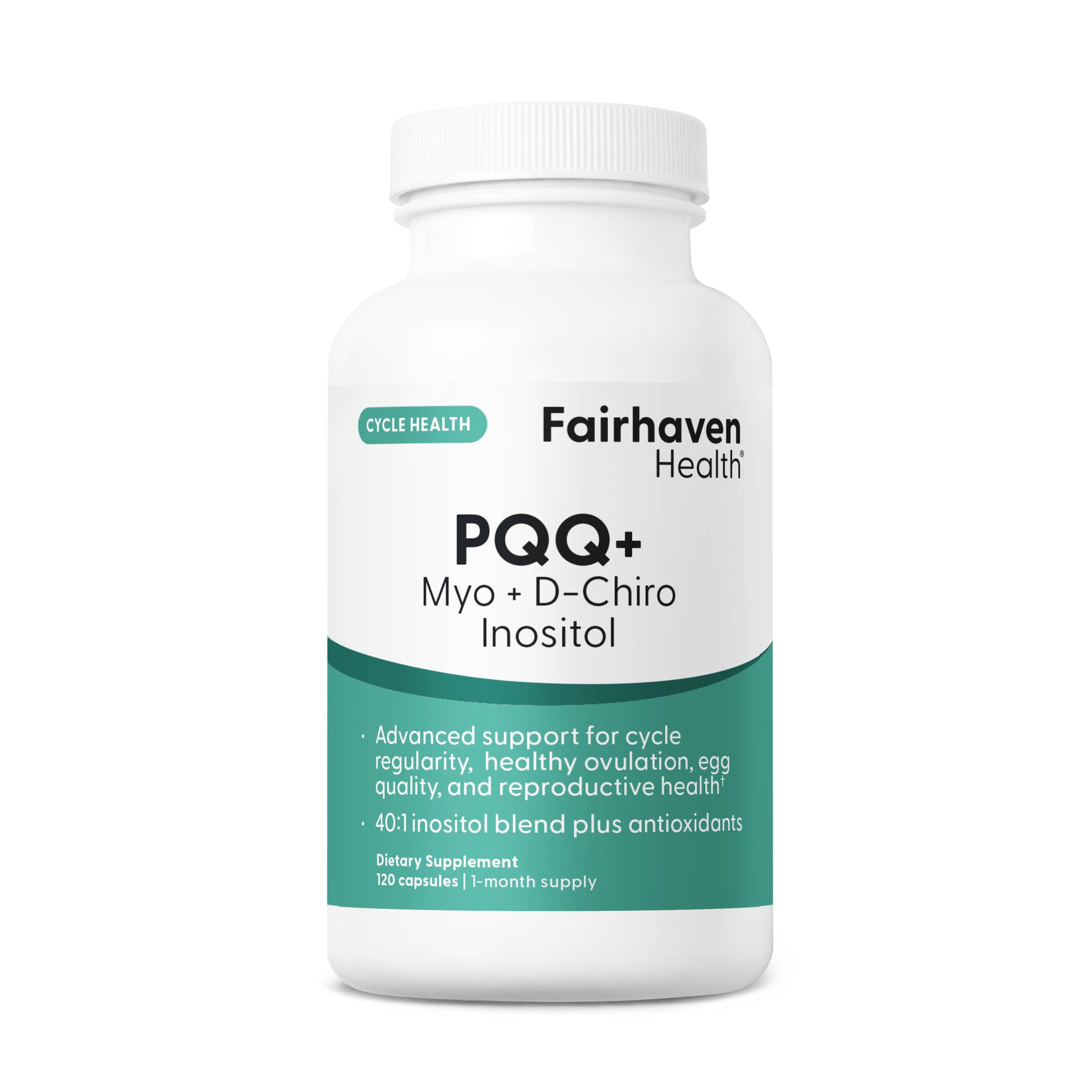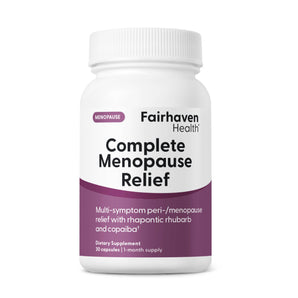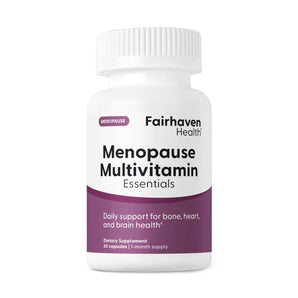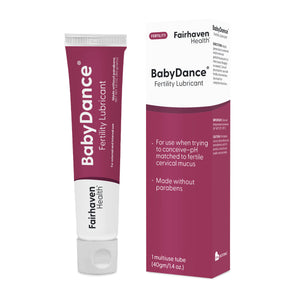By Avni Dalal, ND
Menopause is a natural phase of life, typically occurring between ages 45 and 55, marked by the end of menstrual cycles and a significant shift in hormone levels—especially estrogen and progesterone. The hormonal changes that occur in perimenopause and menopause can trigger a wide array of physical and emotional symptoms that may vary in intensity and duration.
In this two-part blog series, we’ll first explore the 13 major symptoms of perimenopause and menopause, breaking down why they happen from a physiological standpoint. In Part 2, we’ll dive into evidence-based dietary, lifestyle, and nutritional support strategies for each.
1. Hot Flashes
Hot flashes are sudden, intense feelings of heat, often accompanied by flushing and sweating. Hot flashes stem from decreases in estrogen and FSH levels, which can disrupt the hypothalamus and cardiovascular system. With these changes, the body's thermostat in the hypothalamus is less sensitive, and the vasculature important to cooling is less responsive.1
There is also an imbalance between glutamatergic and GABAergic neurons in the hypothalamus. During menopause, the number of glutamatergic neurons decreases while the number of GABAergic neurons increases. This imbalance affects the body’s ability to regulate temperature effectively, leading to hot flashes.1
2. Night Sweats
Similar to the mechanism of hot flashes, night sweats are essentially hot flashes that occur during sleep and can severely impact sleep quality. They result from the same thermoregulatory instability and are influenced by fluctuating hormone levels during perimenopause and menopause.1
Additionally, the thermoneutral zone, which is the temperature range where the body maintains our core temperature without needing to sweat or shiver, gets altered during menopause where declining estrogen narrows this zone. This can lead you to feel more sensitive to slight temperature changes.2
3. Menstrual Anxiety
The mechanisms for why anxiety can worsen or new onset anxiety occur in menopause are multifaceted, primarily involving the decline in estrogen and FSH levels and its impact on the hypothalamus and neurotransmitter balance.
Fluctuating hormones—particularly progesterone and estrogen—affect neurotransmitters like GABA and serotonin, which regulate anxiety and mood. In perimenopause, irregular hormone surges or drops can intensify premenstrual anxiety before cycles completely cease.1,3 In fact, estrogen withdrawal disrupts the normal function of the hypothalamus, resulting in altered cortisol levels and an increased vulnerability to stressors.3,4
4. Negative Mood
As we’ve previously mentioned, estrogen plays a role in modulating serotonin and dopamine, both of which influence mood changes.1,3 As levels decline, mood imbalances, including sadness and low motivation, may arise, particularly in those with a history of depression or heightened stress.
Another part of why menopause affects mood is due to decreased signaling to brain-derived neurotrophic factor (BDNF). A decrease in BDNF levels can contribute to depressive symptoms and issues with mood regulation by weakening synaptic connections and neuroplasticity.5
5. Irritability
Hormonal shifts, hot flashes, sleep disturbances, and changes in brain chemistry all contribute to irritability. Low progesterone, in particular, may reduce calming GABA activity, leading to heightened emotional reactivity.
An additional part of the picture is thinking about neuroinflammation. Low levels of estrogen lead to immune imbalance and elevated levels of inflammatory cytokines, which disrupt neurotransmitter functions and neuroplasticity to cause mood disturbances and irritability.4,6
6. Sleep Disturbance
Declining estrogen and progesterone levels can interfere with melatonin production and the expression of genes that are associated with regulating our internal clock, leading to a disrupted circadian rhythm.7,8 Hot flashes, night sweats, anxiety, and increased cortisol levels also make it harder to fall or stay asleep.
7. Exhaustion
Chronic sleep disruption, hormone imbalances, and shifts in metabolism contribute to persistent fatigue or exhaustion. Estrogen also helps maintain function of the mitochondria, “the powerhouse of our cells,” so low levels may impact cellular energy production.
8. Low Libido
Estrogen and testosterone both play roles in sexual desire. The decline in estrogen along with testosterone leads to lower blood flow to the pelvic region, vaginal lubrication, and arousal response–all of which reduce sexual interest or satisfaction.1,4,9 Menopausal women also show lower gray matter volumes in the brain regions that are involved in the sexual response.10
9. Urinary Tract Complaints
Estrogen supports the health of the urethra and bladder lining. Its decline can result in thinning tissues, decreased muscle tone, and increased susceptibility to urinary tract infections (UTIs), urgency, or incontinence.10 Estrogen also plays a role in maintaining the normal vaginal microflora, which includes lactobacilli that help prevent infections. The decline in estrogen changes vaginal pH and microflora, increasing the risk of UTIs and contributing to recurrent UTIs in postmenopausal individuals.11,12
10. Heart Complaints
Menopausal individuals may report heart palpitations or a racing heart, which can be due to declining estrogen’s effects on autonomic nervous system regulation and vascular elasticity. Lower levels of estrogen also causes lower production of nitric oxide (NO), which is essential for vasodilation.13,14 These symptoms can be unsettling, but are often benign and linked to hormonal changes.
However, it is important to note that these hormone changes cause accelerated vascular aging, disrupted heart cell (cardiomyocyte) function, and microvascular dysfunction, all of which can contribute to an increased risk of cardiovascular disease.15,16,17 It’s always wise to speak with your healthcare provider for proper symptoms and risk assessment and consider adding additional support for heart health in menopausal years.
11. Vaginal Dryness
Estrogen maintains vaginal tissue elasticity, pH, and lubrication. When levels drop, the vaginal lining becomes thinner and drier, increasing discomfort during intercourse, certain physical movements, and raising the risk of irritation and infection.10
12. Joint & Muscle Complaints
The reduction in estrogen can lead to increased systemic inflammation and muscle protein degradation, leading to joint pain, stiffness, or generalized muscle aches.18.19 Estrogen deficiency leads to the degeneration of joint tissues like cartilage and slower recovery from injuries, therefore increasing the risk of conditions such as osteoporosis, sarcopenia, osteoarthritis, and lumbar facet joint arthritis.18,19
13. Headaches
Hormonal fluctuations—especially estrogen withdrawal—can contribute to vascular instability and trigger migraines or tension headaches, particularly in those with a preexisting history of hormonally linked headaches.20 Estrogen deficiency also leads to increased mast cell density, leading to an increase in inflammatory mediators that can trigger headaches.21
Coming up Next: How to Manage These 13 Symptoms Naturally
Now that we’ve thoroughly explored the why behind these common symptoms of menopause, Part 2 of this blog series will provide science-backed strategies to help manage each symptom—including lifestyle habits, dietary suggestions, and targeted nutrients or herbs that support hormonal balance and overall well-being.
References:
1. Sun Y et al. Front Aging Neurosci. 2022;14:993955.
2. Freedman RR. J Steroid Biochem Mol Biol. 2014;142:115-120.
3. Wang H et al. Heliyon. 2024;10(6):e27976.
4. Fidecicchi T et al. Maturitas. 2024;188:108087.
5. Chhibber A et al. Psychoneuroendocrinology. 2017;82:107-116.
6. Han Y et al. Front Psychiatry. 2023;14:1162501.
7. Troìa L et al. J Clin Med. 2025;14(5):1479.
8. Dorsey A et al. Front Neurosci. 2021;14:625397.
9. Bachmann GA et al. Menopause. 2004;11(1):120-130.
10. Moon CM et al. J Clin Med. 2024;13(2):387.
11. Lüthje P et al. Maturitas. 2014;77(1):32-36.
12. Lüthje P et al. Sci Transl Med. 2013;5(190):190ra80.
13. Somani YB et al. Am J Physiol Heart Circ Physiol. 2019;317(2):H395-H404.
14. Moreau KL et al. Geroscience. 2020;42(6):1699-1714.
15. Moreau KL. J Appl Physiol. 2018;125(6):1881-1887.
16. Adekunle AO et al. Front Cell Dev Biol. 2021;9:685996.
17. da Silva JS et al. Int J Mol Sci. 2022;23(23):15140.
18. Bay-Jensen AC et al. Menopause. 2013;20(5):578-586.
19. Pellegrino A et al. Sports Med. 2022;52(12):2853-2869.
20. Allais G et al. Neurol Sci. 2018;39(Suppl 1):11-20.
21. Boes T et al. Cephalalgia. 2012;32(12):924-931.











